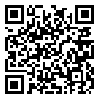Volume 9, Issue 1 (4-2021)
J Surg Trauma 2021, 9(1): 26-31 |
Back to browse issues page
Download citation:
BibTeX | RIS | EndNote | Medlars | ProCite | Reference Manager | RefWorks
Send citation to:



BibTeX | RIS | EndNote | Medlars | ProCite | Reference Manager | RefWorks
Send citation to:
Amouzeshi A, Salehi F, Ehsani H, Jomefourjan S, Jani M, Amouzeshi Z. Comparison of pulse oximetry and clinical examination for proper tissue perfusion in congenital heart patients. J Surg Trauma 2021; 9 (1) :26-31
URL: http://jsurgery.bums.ac.ir/article-1-272-en.html
URL: http://jsurgery.bums.ac.ir/article-1-272-en.html
Ahmad Amouzeshi 

 , Forod Salehi
, Forod Salehi 

 , Hossein Ehsani
, Hossein Ehsani 
 , Somaye Jomefourjan
, Somaye Jomefourjan 
 , Mohammad Jani
, Mohammad Jani 
 , Zahra Amouzeshi *
, Zahra Amouzeshi * 




 , Forod Salehi
, Forod Salehi 

 , Hossein Ehsani
, Hossein Ehsani 
 , Somaye Jomefourjan
, Somaye Jomefourjan 
 , Mohammad Jani
, Mohammad Jani 
 , Zahra Amouzeshi *
, Zahra Amouzeshi * 


Instructor, Faculty of Nursing and Midwifery,Cardiovascular Diseases Research Center, Birjand University of Medical Sciences, Birjand, Iran
Abstract: (2691 Views)
- Introduction: One way of monitoring angiographic organ is the clinical examination that is dependent on the accuracy of the person performing it; Therefore, human error may be high and require frequent examination is at least 24 hours after angiography. Meanwhile, checking for arterial or intravenous blood gases due to the small size of the vein and the arteries in children is difficult, unlike adults is difficult and requires skill and mastery in the field of venipuncture. Therefore, it is advisable to use simpler and less costly methods such as pulse oximeters to monitor organs that are more accurate and comfortable for the staff and patient. Therefore, this study was conducted to compare post angiography pulse oximetry and physical exam in cardiac congenital of pediatric patients.
- Methods: This study was conducted with 45 patients with congenital heart disease undergoing diagnostic or therapeutic angiography. They were selected by convenience sampling method from among patients referring to the angiography department of Vali-e-Asr Hospital in Birjand, Iran, in 2016. Trained personnel performed the clinical examinations, including temperature, colour, and pulse check (dorsalis pedis and tibialis posterior) for both the angiographic and control organs. Pulse oximetry was also performed concurrently using the Massimo pulse oximeter for both organs and continued for up to 6 hours after angiography. Demographics form and patients' clinical records were used to collect data. The obtained data were analyzed in SPSS software (V: 23) using the Kappa test.
- Results: The agreement between the pulse oximetry of the angiographic and control organs was mild only at one, two, and six hours after angiography, and was moderate three hours after angiography (kappa=0.656 after three hours).
- Conclusions: Although there was no clinical agreement between pulse oximetry and clinical examination, according to our findings pulse oximetry is more accurate, and given the results in the first one to two hours after angiography evaluation of organ is more sensitivity.
Type of Study: Research |
Subject:
General
Received: 2021/03/14 | Accepted: 2021/04/17 | ePublished ahead of print: 2021/04/18 | Published: 2021/04/20
Received: 2021/03/14 | Accepted: 2021/04/17 | ePublished ahead of print: 2021/04/18 | Published: 2021/04/20
Send email to the article author
| Rights and permissions | |
 |
This work is licensed under a Creative Commons Attribution-NonCommercial 4.0 International License. |





